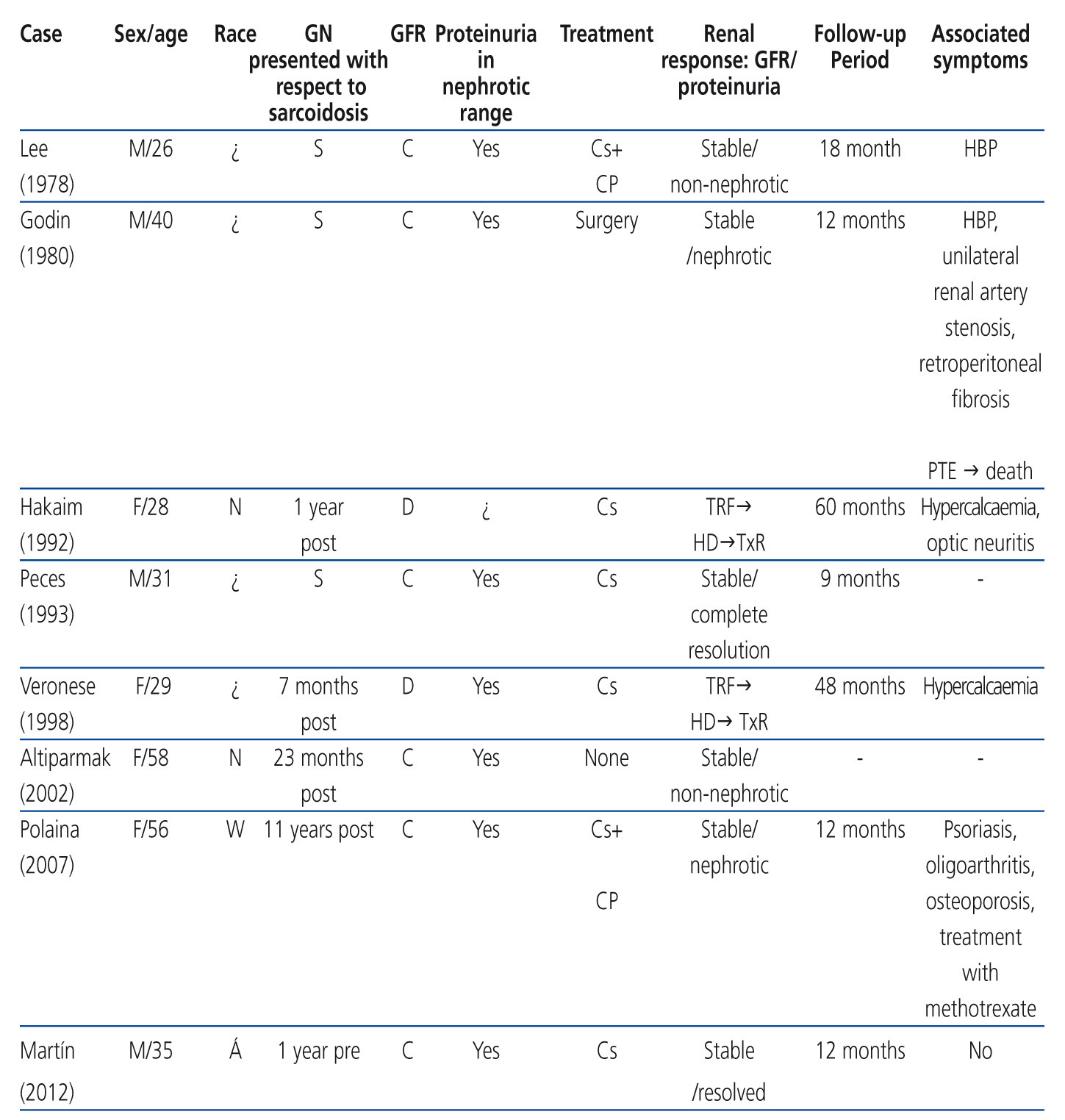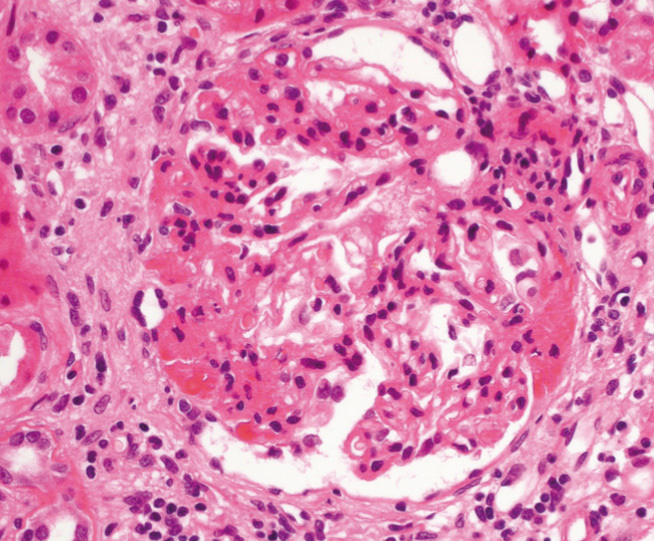Content
To the Editor:
Sarcoidosis may induce interstitial granulomatous nephritis (15%-40%), abnormalities in the calcium-phosphorus balance (hypercalciuria 50%, hypercalcaemia 10%), distal tubulopathy with diabetes insipidus, obstructive uropathy and membranous glomerulonephritis (GN); to a lesser extent membranoproliferative, mesangial or focal segmental glomerulonephritis (FSGN). We report a relevant case.
Our patient is a 35-year-old Moroccan male, with no previous illnesses. He sought consultation due to proteinuria. Physical examination without findings. Blood test plasma creatinine 1.1mg/dl, creatinine clearance 97ml/min/1.73m2, non-selective glomerular proteinuria 3.67g/d. Albumin 3.9mg/dl, cholesterol 239 mg/dl, urine analysis with proteinuria 300mg/dl and microhaematuria. Red blood cell sedimentation rate 8mmHg 1st hour, viral serology, tumour markers, thyroid profile, immunology, protein electrophoresis, serum and urine protein immunoelectrophoresis, hepatopancreatic profile and chest radiograph normal. Renal ultrasound with kidneys of 110 and 114mm and conserved cortex. Renal biopsy (Figure 1) showing 7 glomeruli: 3 sclerotic, 4 with hyaline segmental lesions, cellular proliferation and synechia, mesangial expansion, fibrosis and grade I/III tubular atrophy, lymphoplasmacytic interstitial infiltrates. Arteries and arterioles without lesions. In the direct immunofluorescence: IgM and C'3 deposits in the mesangium. Electron microscopy (EM) was not conducted. When he was diagnosed with FSGN, he was treated with angiotensin converting enzyme inhibitors (ACEI). At 3 months proteinuria had decreased to 1g/d. Dual blockade was started (ACEI and angiotensin II receptor antagonists). At 6 months, the glomerular filtration rate (GFR) remained stable and proteinuria was at 0.5-0.7g/day. At 12 months, he started to experience abdominal pain, diarrhoea, vomiting and increased amylase. Computerised tomography (CT) of the chest and abdomen was performed, revealing lateral cervical, axillary, hilar, mediastinal and liver hilar lymphadenopathy and centrilobular nodules. Bone series and thyroid profile normal, serology for Epstein-Barr virus, cytomegalovirus, rubella, brucellosis, syphilis and toxoplasma and tumour markers negative, angiotensin converting enzyme 46.3U/l (range 20-70), 25OH vitamin D3 15.3ng/ml, 1-25 di(OH) vitamin D3 45.4ng/ml (range 18-78), intact parathyroid hormone 30pg/ml (range 15-60), urinary calcium 40mg/d, phosphaturia 732mg/d, calcaemia 10mg/dl, phosphataemia 3.0mg/dl. Bronchoscopy with bronchoalveolar lavage and needle aspiration of mediastinal lymph node cellularity showing macrophage predominance. Transbronchial biopsy suggestive of non-necrotising granulomatous inflammatory process, accumulations of histiocytes and giant multinucleated cells. Zhiel-Neelsen and Lowenstein culture negative. Bronchoalveolar lavage with lymphocyte predominant cellularity and increased CD4/CD8 ratio. With sarcoidosis being diagnosed, treatment with prednisone began and was maintained for 12 months. He evolved favourably. CT at 6 months revealed disappearance of mediastinal lymphadenopathy and parenchymal involvement. After 24 months, the GFR remained stable, proteinuria of 0.5g/d was maintained and there were no relevant incidents.
The association between sarcoidosis and FSGN dates back to 1978.1 Only 7 cases are described in PubMed1-7 (Table 1). They affect 50% of males, with a mean age of 37.8 years. In all, proteinuria was in the nephrotic range. Renal failure only occurred in 2 cases and both progressed to the end stage, requiring haemodialysis and subsequently a kidney transplant. In all cases, the response to pulmonary symptoms was good, however this was not the case for the evolution of proteinuria, which remained in a nephrotic range in 4, decreased quantitatively in 2 and was resolved in 2 others. GN diagnosis after sarcoidosis diagnosis occurred in 50% of cases. In all biopsies there was glomerular sclerosis, focal segmental lesions and hyalinosis. There was only tubular atrophy in 5, interstitial inflammatory infiltrates in 4, synechiae and increased mesangial matrix in 3, periglomerular fibrosis in 2 and negative direct immunofluorescence in 2 with deposits of IgG in 1, C'3 in 4, IgM in 4 and C'1q in 1 case located in the mesangium and subendothelium. EM was only performed in 2 cases, both revealed podocyte fusion and lack of immune complex. In just one2 of the cases described, renal interstitial granulomas were found with 12.5% involvement, lower than that reported in literature (15-40%). The good evolution of GFR and proteinuria with conservative treatment was notable and it did not improve by adding corticosteroids for their lung disease.
This association can be paradoxical. In sarcoidosis, there is an immune imbalance with upregulation of the TH1 pathway, and in FSGN upregulation of the TH2 pathway.8,9 However, in late stages TH17 predominates, inducing secretion of interleukin 1710 favouring the development of fibrosis. Cardiotrophin-like cytokine 1, involved in the development of FSGN, is increased in pathway TH17,11-13 which may be the link between both.11
We present the case of a patient with FSGN onset who that year was diagnosed with sarcoidosis, with good pulmonary and renal evolution on treatment with corticosteroids and blockade of the renin–angiotensin-aldosterone system.
Conflicts of interest
The authors declare that they have no conflicts of interest related to the contents of this article.
Table 1. Summary of published cases of focal segmental glomerulonephritis associated with sarcoidosis
Figure 1. Focal segmental glomerulosclerosis









